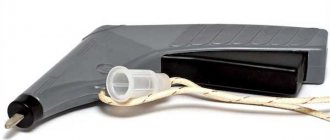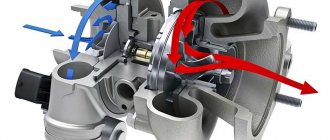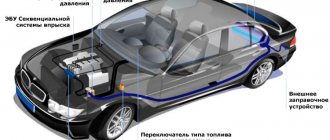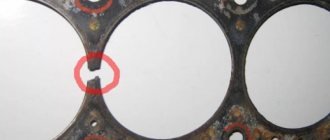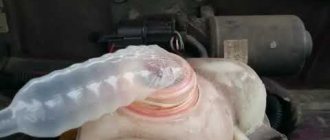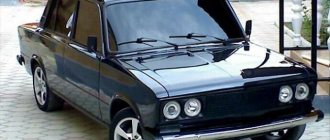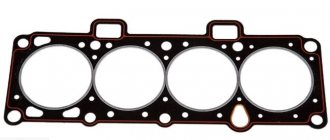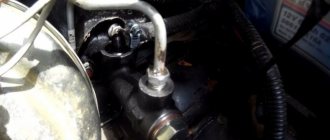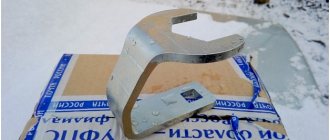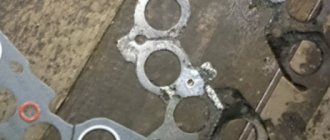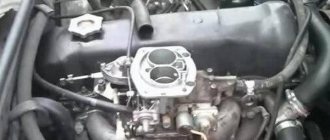Extreme girl
If the cylinder head gasket were speechless, she would constantly complain about life. Indeed, the conditions in which she has to work cannot be called anything other than extreme. In addition, these conditions are not the same for different sections of the mating surfaces. Without boring readers with numbers, we will only paint a qualitative picture.
Along the perimeter of the cylinder, the gasket is exposed to gases in a fairly wide range of pressures and temperatures - from frosty air during winter parking to an aggressive flame front during combustion of the fuel-air mixture. In addition, the gasket comes into contact with oil, coolant, fuel and combustion products of the working mixture - and all this under conditions of high temperatures and pressures.
And now about the mechanics. Imagine: during the working stroke of the piston, the block head tends to bend and move upward, pulling out the studs or bolts. Naturally, this process is cyclical. Therefore, the gasket is subjected to pulsating compression, and the studs are subject to pulsating tension.
But that's not all. At the cylinder head joint, local thermal loads arise during engine operation. Therefore, the installation forces must ensure such compression stresses in the gasket that compensate for both gas pressure and temperature stresses. These requirements determine the tightening torque of the studs or bolts specified in the vehicle's operating instructions.
Signs of a broken cylinder head gasket.
The essence of a cylinder head gasket failure is a violation of the tightness of the engine cavities, which are sealed by this gasket. As a result of a violation of the tightness of the engine cavities, the contents of these cavities (exhaust gases, antifreeze or oil) escape beyond the occupied cavities with penetration either into adjacent cavities or outside the engine. Blow-through occurs when exhaust gases partially escape from the cylinder in the wrong direction. During normal operation, exhaust gases from the cylinder enter the exhaust system through the exhaust valves. If the cylinder head gasket is damaged, gases may escape: - into the adjacent cylinder (manifested by a decrease in engine power, poor starting, unstable engine operation). An instrumental study reveals a drop in compression in two adjacent cylinders. - outside the engine (manifested by a decrease in engine power, poor starting, unstable engine operation, noise during operation). During inspection, you can often observe how gases escape at the junction of the head and the cylinder block. An instrumental examination reveals a drop in compression in one cylinder. — into the cooling system (manifested by an increase in pressure in the cooling system, the release of coolant into the expansion tank, and the appearance of coolant gas bubbles). Antifreeze leakage can occur in: 1. Inside the cylinder - manifested by thick white smoke from the exhaust system, antifreeze consumption. 2. Outside the engine - the surface of the engine is contaminated with antifreeze. 3. Inside the oil system - increasing the oil level in the crankcase, forming an antifreeze-oil emulsion. Oil leakage can occur in: 1. Outside the engine - the surface of the engine is contaminated with oil. 3. Inside the cooling system - antifreeze contamination with oil.
You owe us...
The operating conditions of the gasket also determine the requirements for the material for its manufacture. The cushioning material must:
• fill micro- and macro-roughnesses of joining surfaces well;
• maintain elasticity due to low dynamic shrinkage under cyclic loads;
• do not relax, maintaining the applied contact pressure for a long time;
• be sufficiently thermally conductive;
• resist the leaching of any fillers and ingredients from your own “body”;
• do not swell or collapse upon contact with coolant, oil and various types of fuel, as well as exhaust gases.
If you read this “witches’ hammer” to the end, it means you have strong nerves. What if you approach it formally? The formal requirements are set by the customer - the engine plant. While writing them, he will write a whole “sheet”. Lists the necessary physical and mechanical properties of the gasket in percentages: compressibility, recoverability and shrinkage of the material at given pressures and temperatures. It will require a strictly defined increase in the thickness and mass of the gasket material in oil, antifreeze and fuel.
And the end user - a driver or mechanic - will express his aspirations more briefly: the gasket should reliably seal the joint, not “break through” during operation and not require frequent tightening, and ideally do without it at all. He, the consumer, simply wants to tighten the head to the required torque, and move on.
In addition, craftsmen often encounter gaskets sticking to mating surfaces. This entails labor-intensive scraping of the “remains” of the gasket when replacing it, accompanied by characteristic comments that the author of the article decided not to present here.
Engine gaskets: main functions
As in any other case, the main task of the gasket is to ensure the tightness of a particular unit, device or mechanism. The internal combustion engine is no exception.
Technical fluids constantly circulate inside this complex mechanism during operation. Moreover, these liquids are under a certain pressure. In order for the specified pressure to remain at the required level, and also to prevent leakage of liquids from the housing, tightness is necessary.
As you can see, gaskets help prevent various leaks of working fluids and lubricants from mechanisms, as well as prevent dust, moisture and dirt from entering from the outside. The use of gaskets allows you to achieve an ideal and tight fit between two surfaces, eliminating certain errors in their processing.
The gasket is able to follow the shape of the parts, and thanks to its softness and elasticity, it is possible to smooth out unevenness, roughness and other minor defects. It turns out that the solution seals the housing, seals the internal components of the motor, and prevents leaks of technical fluids.
Jokes aside
However, if you think about it, both the customer and the end user will say the same thing. Take, for example, the compressibility of a gasket. The lower it is, the stricter the requirements for the quality of sealed surfaces will be. And vice versa - high compressibility will “forgive” some flaws of these surfaces. In other words, compressibility determines the very tightness of the joint, without which a seal is not a seal, and repair is not a repair.
And the optimal combination of compressibility and recoverability will allow you to do without additional tightening of the cylinder head and adjustment of valve clearances.
Let's get acquainted with the main trends in engine construction as it relates to the production of gasket materials. According to a number of foreign seal manufacturers, the trends are as follows:
• compact engine design, small sealing surface area, “soft” castings of the block and its head;
• growth in the number of small-sized diesel engines for passenger cars;
• increase in operating temperatures and pressure peaks during combustion of the mixture;
• complete elimination of additional “tightening” of the gasket;
• international unification of technologies, the emergence of uniform standards for automotive gaskets and other spare parts;
• the popularity of the “no leak philosophy”, and, as a consequence, the expected increase in the warranty period for the tightness of any connection.
Thus, engine building does not stand still; engine designers are continuously improving their creations. Their arsenal includes the use of turbocharging, increasing the crankshaft speed and compression ratio, as well as the use of the latest structural materials. So, gasket manufacturers must keep up with engine manufacturers? But they guessed wrong - they must go ahead. In other words, they need to be constantly ready to order the “gasket of tomorrow.”
Selecting a cylinder head gasket
To replace the cylinder head gasket, you must purchase a new part. As in the situation with other engine elements, you can find an original or non-original cylinder head gasket on sale. When choosing the second option, you should pay special attention to the company that produces the part. You can find a gasket several times cheaper than the original one, which will not be inferior in quality.
To buy a cylinder head gasket, you need:
It is better to purchase a cylinder head gasket in large automobile stores, where sellers can choose the best option for a specific engine.
Types of cylinder head seals
Speaking about sealing block-head joints, we will not consider engines with unlined joints - this is a topic for a separate discussion. In other cases, experts divide seals into three groups:
• soft cylinder head gaskets;
• metal cylinder head gaskets;
• combined seals.
However, with regard to metal and soft gaskets, a reservation is necessary. Both are made from several materials - for example, soft pads contain perforated sheet metal. But one of the materials (metal or polymer composition) is predominant - it is this that determines whether the gasket belongs to one group or another.
For example, on diesel engines of the Chelyabinsk Tractor Plant for military tracked vehicles and tanks, a gasket consisting of two copper sheets was used. A sheet of asbestos paper 1 mm thick was placed between them. The lower metal sheet had a flange not only for the openings of the combustion chambers, but also for the oil channels.
There are graphite gaskets made from graphite sheets (not to be confused with the graphite coating of asbestos gaskets and the graphite filler of non-asbestos materials). However, leading foreign manufacturers recognize them as unpromising.
We will return to metal and combined seals later, but now let’s talk about soft cylinder head gaskets. Their advantages are determined by their simplicity: thanks to their “softness,” they compensate for unevenness and deformation of the mating surfaces, thereby ensuring sealing of the joint. Hence the relative cheapness of these products.
The disadvantages include less reliable sealing compared to metal “sisters” (especially at high pressures), the need for additional tightening during operation and, as a rule, one-time use.
Modern cylinder head gaskets.
The cylinder head gasket is used in the repair of not only domestic cars, but also foreign ones. It serves to eliminate all possible oil leaks when supplied to the engine and to seal the combustion chamber. The cylinder head gasket also affects the elastic deformation of parts.
Typically, cylinder head gaskets are made from multilayer plastic (combined) or metal compounds. Often the cause of engine problems is found in the cylinder head gasket. For example, if the engine overheats, if there is an oil or water leak, etc. Professionals know that high-quality cylinder head gasket cannot be done in “makeshift” conditions. The cylinder head is one of the most important elements of the engine, so breakdowns and defects of the cylinder head should be taken seriously.
Problems may arise when it is necessary to replace the cylinder head gasket of some foreign cars. It must be remembered that poor-quality replacement or repair of the cylinder head can lead to serious problems - increased fuel consumption, reduced engine life and a decrease in engine power as a whole.
Make her
Cylinder head gaskets are cut out of multi-layer fabric. It is based on a frame made of perforated sheet metal, coated on both sides with a polymer composition. In other words, a modern soft cylinder head gasket is a multilayer structure, a kind of “sandwich” in which each layer solves a strictly defined task.
In order to use terms freely in the future, let’s recall in general terms the technology for manufacturing cylinder head gaskets. Its main stages are as follows:
• production of special polymer-based paper;
• perforation of sheet metal;
• assembly of the spacer sheet (the sheet is covered with paper and passed through the crimping rolls of the calender);
• coating, impregnation and vulcanization of the resulting material;
• cutting out gaskets in special dies.
• edging of openings of combustion chambers and liquid channels of gaskets and calibration.
To be fair, we note that the use of polymer paper is not the only way to produce canvas. At one time, the Elring company proposed the following technology: the tin is covered with a specially prepared mass and then passed through a calender. But, for example, the Frenzelit company covers tin with paper - however, this requires a special paper-making machine. But this method provides a more uniform density of the canvas.
What are cylinder head gaskets?
The cylinder head (cylinder head) is one of the main components of the above-piston cavity, where all the thermal processes of the working cycle take place.
Engine performance depends on the quality of the cylinder head gasket and its installation. Defects and incorrect installation may result in engine failure. Therefore, replacing the cylinder head gasket should be approached very seriously and carefully, choosing only high-quality gaskets. The gasket itself is a high-tech and complex part made of several layers with a frame made of perforated thin-sheet steel. Its main purpose is to seal the joints of the cylinder head with the engine cylinder block.
]cylinder head gaskets[/anchor] must be tested for their tightness, corrosion resistance, etc. This should ensure full compliance of the gasket with the technical and design conditions for 100% sealing of the engine. cylinder head gaskets is relevant , since it is in them that the load on the head gasket is very high, because the pressure in the engine itself is very high. All this leads to damage to the gasket.
The most important characteristic of a cylinder head gasket is its high temperature resistance, which guarantees its long service life. For an accurate sealed connection between the cylinder head and the block itself, precise stamping and special processing of the gaskets are required. Manufacturers sometimes screen-print silicone onto the surface of the gaskets for a better seal.
This is tough
And now some interesting details. The surface of the tin after perforation most closely resembles, perhaps, a double-sided grater. The teeth on both sides of the steel strip are ready for contact with the polymer coating - but do all manufacturers do them correctly?
Of course not. Currently, there are two types of perforations used in the production of cylinder head gaskets: round and rectangular. “Advanced” factories use round, and here’s why.
Firstly, with round perforation, the strength of the sheet metal in the longitudinal and transverse directions is almost the same. While rectangular perforation makes the gasket anisotropic. In addition, the “rectangular” technology does not ensure reproducibility of product properties: two identical gaskets can differ significantly in tensile strength.
Secondly, the circular perforation allows for a flat surface between the protrusions (teeth). And finally, thirdly, it makes it possible to optimize the distribution of teeth over the area of the product, ensuring reliable adhesion of the sheet metal to the polymer “blanket”.
After grinding the cylinder head, what gasket to install?
| Place | Name | Characteristics in the rating |
| Top 9 best cylinder head gasket manufacturers |
| 1 | REINZ | Highest degree of reliability |
| 2 | ELRING | Best quality original products |
| 3 | AJUSA | The most durable |
| 4 | GLASER | The best gasket after grinding the cylinder head |
| 5 | CORTECO | The optimum ratio of price and quality |
| 6 | NIPPARTS | Proven quality and reliability |
| 7 | GOETZE | Reliable protection against counterfeiting |
| 8 | SWAG | Buyer's Best Choice |
| 9 | ASHIKA | Reliability. Affordable price |
And as a result...
So, the interlining web is assembled by passing perforated sheet metal and paper through the rollers of a calender. Rational perforation of the tin base and for polymer composites allows the gasket to adapt to vertical loads - and to any, even very large ones. In this case, dangerous peaks “spread” without breaking the compaction - the developers call this process “horizontal alignment”. And one more thing: when using new gaskets, the forces are distributed evenly along the edges of the liners, protecting the cylinders from deformation and, consequently, from increased oil consumption, accelerated wear and gas breakthrough into the crankcase.
And if in numbers: what mechanical and temperature loads can these products withstand? Please: according to manufacturers, gaskets for gasoline engines remain operational up to 35 MPa (350 bar) and 350° C, and for diesel engines - up to 100 MPa (1000 bar) and 400° C. That is, the “safety margin” of the product is considerable...
Optimally selected indicators of recoverability and compressibility allow long-term operation of the gasket without additional adjustment of the valve mechanism - in a word, everything for the consumer! And the special non-stick coating makes it easy, and most importantly, painless for the engine, to remove the gasket during repairs.
And now a few words about the edging of the gas holes. This element performs several functions: firstly, it strengthens and protects the edges of the holes; secondly, it increases the bending strength of the gasket, which is important during its transportation and installation; thirdly, it acts as a thermal bridge between the masses of the block and the head.
When purchasing a cylinder head gasket, you need to pay special attention to the surround. “Accordions” of metal are not allowed, as well as excessively large protrusions above the plane of the gasket - otherwise, when tightening the head, the above-mentioned deformation of the sleeves may occur.
The total (on both sides) height of the edging beads should not exceed 0.3 mm, and experienced craftsmen “catch” it by running a fingernail along the part. However, for modern gaskets these skills are not needed: the height of the indicated beads on modern gaskets is calculated not in tenths, but in hundredths of a millimeter.
Modern metal gaskets can effectively solve many engine sealing problems (photo courtesy of Fritex OJSC)
After grinding the cylinder head, what gasket to install?
Hello! OPEL ZAFIRA, 2007 mileage 159,000 km, Z18XER engine. Overheated. Please tell me, after boring the cylinder head by 0.19 and the block by 0.15, what cylinder head gasket should be installed? Or are there any other options? Thank you.
Diesel engines are equipped with cylinder head gaskets of varying thicknesses. Their thickness depends on whether the pistons used in a given engine have technological deviations at the top or bottom. Since the cylinder head gasket is located between the cylinder block and the cylinder head, it is possible by selecting its thickness to vary the height of the combustion chamber and thus equalize the differing heights of the pistons. The thickness of the gasket is determined by the number of small holes or notches on the side of the gasket. shown in Fig. Holes or notches are visible from the outside on an already installed block head.
If only the cylinder head of the engine is replaced or the old head is removed and then installed, then you can buy a new gasket simply based on the old one, i.e. with the same number of holes or notches. If parts of the piston group are replaced (crankshaft, connecting rods, pistons) or the cylinder block is completely replaced, it is necessary to re-measure the protrusion of the pistons. This is a measure of how much the pistons protrude above the cylinder block. According to the table, the required gasket is selected.
Cylinder head grinding in garage conditions
Have a nice day, dear motorists! Most likely, it is no secret to you that
the cylinder head is a very specific part of a car engine. All systems and parts of the cylinder head are very tightly woven together, and any failure of parts is usually a consequence of a more important flaw in the cylinder head.
A little about “metal”
As already mentioned, metal gaskets are made from several layers of steel, copper or brass sheets or combinations thereof.
A textbook (and already consigned to history) example of such seals is the cylinder head gaskets of the YaAZ-206 engine for the first generation of KrAZ heavy trucks. By the way, the prototypes of these 6-cylinder two-stroke diesel engines were American GMC engines - therefore, the method of sealing them came to us from overseas. However, Americans need not puff out their cheeks, since the birthplace of metal gaskets is Japan.
But let's return to the YaAZ-206. These two-stroke diesel engines had a compression ratio of 17 and a stud torque of 24 kgm (~240 Nm). The gaskets for them were assembled from six 08KP steel sheets with a thickness of 0.26 and 0.4 mm. One sheet had a special flange in the holes for the combustion chambers. The studs were spaced evenly around the cylinder, giving a good seal.
Modern automobile engines with a steel gasket include Japanese Komatsu four-stroke diesel engines, Daimler passenger diesel engines and a number of other famous engines.
The advantages of metal gaskets include the highest operational reliability and the possibility of repeated use. The disadvantages are significant tightening forces on the studs, which require high rigidity of the block, considerable dead weight of the gasket and a hefty cost.
In addition, metal gaskets require special precision and cleanliness in the manufacture of mating parts. However, for the same Daimler this is the everyday norm, and it’s not a sin to pay for quality.
Engine gaskets: purpose, types and features of automotive gaskets
As you know, the entire car as a whole and the car engine itself are a collection of many metal, plastic, rubber and other parts. As for the internal combustion engine, in addition to elements made of metal and various alloys, various sealing elements and gaskets are actively used in the design of the power plant.
At the same time, not all car owners fully understand why gaskets are needed in the engine, as well as what kind of car gaskets there are and how such elements are changed. In this article we intend to look at these issues in more detail.
Great combinators
In combined connections, the combustion chamber is sealed with a metal ring, and the liquid channels are sealed with soft gaskets. What are the benefits of such designs? Here's what: they make it possible to create high contact pressures in small areas - the collars of the sleeves. This ensures reliable sealing with small installation forces compared to the metal gaskets described above.
Each cylinder is closed with a separate aluminum head. The combustion chamber is sealed with a steel ring that is in contact with a “colleague” pressed into the head. And the liquid channels are sealed with a fluorine rubber gasket. Similar solutions are used on Cummins diesel engines, which, by the way, are also found on Kama trucks.
The undoubted advantage of the described combination seals is the ability to open one cylinder without breaking the seal of the others. In general, the use of separate heads for each cylinder and separate elements for sealing combustion chambers and channels of working fluids is used very widely in the diesel industry.
But this is a “separate story”. For, as Kozma Prutkov said, “you cannot embrace the immensity.” Meaning - in one magazine article.
Types of gaskets [ edit | edit code]
- Multilayer steel [2] . Contains from 2 to 5 (usually three) thin steel layers sandwiched with elastomer. The front surfaces have additional channel edging applied with silicone.
- Solid copper. They are characterized by extremely high reliability and are used on special-purpose machines.
- Composite (this is an old technology). Usually built on an asbestos-graphite base. The gas joint has steel rings; the passages are not edged with sealant [3].
- Elastomeric. They have a steel base on which plastic material is applied on both sides. The gas joint has steel rings, the passages are edged with silicone (usually red) sealant.
The cost of a replacement gasket is not particularly high, but the cost of replacing it is significantly higher because about 75% of the repair time is spent removing and installing the cylinder head to free the gasket. However, failure to promptly replace a broken gasket can seriously damage the engine.
Word from the expert
Sergey Afineevsky, Ph.D.
tech. Sciences, leading researcher at FSUE "NAMI" About testing of gaskets
The basis for testing cylinder head gaskets is GOST 12856-96 “Asbestos steel sheets and gaskets made from them.” Currently, this document is part of the Technical Regulations “On the Safety of Wheeled Vehicles”, approved by Decree of the Government of the Russian Federation No. 720 of September 10, 2009.
Gasket testing begins with a visual check: whether there are any breaks, cracks, folds, shells and exposed frames, whether the contours of the product and its geometry correspond to the drawing, what is the condition of the cylinder edgings, whether the stencil is correctly applied to the sealing sealant gaskets, etc.
If everything is good, laboratory tests are carried out on the compressibility and recovery of the gasket, respectively, under a certain load and after its removal.
Then, rectangular samples are cut out of the gasket and see how much they increase the thickness and weight of the gasket under the influence of various liquids: cooling - TOSOL A 50% and water 50%; fuel mixture – 70% isooctane and 30% toluene; motor oil; distilled water; gasoline; diesel fuel. The increase in thickness and weight of samples is estimated as a percentage.
In this way, the reaction of the gasket design to the operating environments it will encounter in a real engine becomes known.
If everything is in order, you are welcome to the engine stand. Here they check: the absence of leaks of antifreeze and engine oil, as well as power, environmental, economic characteristics and other indicators. The most important is the reliability test. The gasket must operate in accordance with GOST 14846-81 (part of the Technical Regulations) a certain number of hours depending on the displacement and type of engine. Let me give you an example: for a gasoline engine with a displacement of 1 to 2.5 liters, this is 300 hours. During the testing process, the passage of gases, oil consumption for waste, etc. are checked. If all “exams” are passed successfully, the gasket is recommended for serial production (in some cases, operational tests with a pilot engine gasket on a car are also possible).
A few words about type-set metal gaskets. They are tested mainly for geometric parameters in accordance with the requirements of the drawings and then motor tests are carried out. I would like to emphasize that the quality of the seal here largely depends on the accuracy of processing of the mating surfaces of the block and head, as well as on the quality of the steel sheet from which the gasket is made. The tolerance for its thickness is no more than 10 microns. If you violated the tolerance, give up your dreams of a reliable seal. Stacked metal gaskets are made of steel type 05KP or 12Х18Н9Т.
How to replace a cylinder head gasket
Replacing the cylinder head gasket is a rather complex procedure as it involves disassembling the engine. Before you begin, you must:
After completing the steps described above, you will be able to get to the gasket. It must be visually inspected for damage. Regardless of whether a breakdown is detected in the cylinder head gasket or not, it will need to be replaced, since it is highly not recommended to reinstall a previously working part. This is due to the fact that it already has a certain deformation, which will not allow the gasket to provide the required tightness. When replacing the cylinder head gasket, it is recommended to inspect the cylinder head and cylinder block for cracks and deformations.
Assembly should be carried out in accordance with the engine manufacturer's recommendations. Read the technical manual for the car, which indicates in what order and with what force to tighten the engine elements.
Important: Experts recommend that when replacing the cylinder head gasket, also change all the mounting bolts. This is necessary because they deform during operation and tightening, losing their geometry and not allowing for complete tightness with the recommended tightening.
( 414 votes, average: 4.52 out of 5)
Related Posts
Stuck piston rings: signs, causes and how to fix
Errors 84 and 89 on Chevrolet Cruze: what they mean and how to get rid of them
A word from the manufacturer
Timur Imnaishvili, Federal Mogul Director of Marketing in Russia, Ukraine, CIS
Efficiency under pressure
In 2009, Federal-Mogul divided its numerous engine product lines into four "expert brands" - AE® for upper engine components (valves, belts, camshafts), Glyco® for bearings, Goetze® for piston rings and liners, and Nural® for pistons and piston kits – each with original equipment pedigree and a wide range of world-class technologies. In 2010, Pauen became Federal Mogul's fifth "expert brand", covering the entire seal category and virtually every application in the EMEA region.
An engine requires a variety of seals. Each requires its own technology, design and material to ensure seal durability and performance. The correct Payen gasket ensures an accurate fit at all times. And a precise fit means seal integrity, extended engine life and customer satisfaction.
Payen offers one of the broadest ranges of sealing technologies available on the market today, from legacy engines to the latest passenger cars and heavy-duty trucks. Our products meet and exceed the requirements of sealing professionals around the world. This means that the parts perform well over a wide range of temperatures and pressures, and meet any surface requirement.
Steel elastomer cylinder head gaskets (S/E)
Some gaskets, especially those designed for high-performance diesel engines, use elastomeric materials molded onto a steel holder. The advantage of this type of system is that the elastomer requires little force to create a seal, and the solid steel holder acts as a pressure limiter, providing a stable connection. More complex gaskets use a variety of elastomers to provide the most suitable material for the specific sealing area. This means minimal structural deformation and excellent resistance to stress relaxation.
Multilayer steel (MLS) cylinder head gaskets
Federal Mogul has been the undisputed leader in multi-layer steel (MLS) cylinder head gasket technology for nearly 20 years. The company has produced more than 43 million MLS cylinder head gaskets at the Herdorf site and is also a leading supplier to the aftermarket. Among the cylinder head gaskets produced in Herdorf is a Pauen part with catalog number AC5300 for the M47 engine - a gasket of the exact same design is supplied to original equipment manufacturers. MLS technology is vital to the efficient operation of today's high-power, high-temperature engines. As the weight and downforce of engine castings decrease, MLS gaskets become critical to providing a strong, reliable seal that accommodates the movement of the cylinder head and block relative to each other. Other benefits include reduced bore distortion and creep, more efficient clamping force distribution, and more precise control of compressed thickness. In addition, MLS technology reduces the dead air space between the cylinder head and the cylinder block in the combustion chamber, helping to reduce emissions of harmful substances.
Cylinder head malfunctions:
- gas breakthrough, causes: curvature of the gas joint, corrosion, damage to fasteners;
- crack, loss of seat;
- wear of the fit under the camshaft or pushers;
- wear of valve guides;
- broken fasteners, broken spark plug threads or bolts, cracks.
Malfunctions of the cylinder head also include breakdowns or wear of such cylinder head parts as: valves, springs, rockers, compensators.
Broken threads for the spark plug are eliminated by installing a screwdriver; the torn fasteners are replaced with repair studs.
Defects in the cylinder head include cracks. A crack in the cylinder head, as a rule, leads to the breakthrough of gases into the cooling jacket and engine failure (in this case, repairing the cylinder head is not advisable). Most often, a crack in the cylinder block is an indication for replacing the part. Cracks outside the gas joint can be welded.
If excessive knocking noises appear and the oil pressure decreases, this may be due to wear of the camshaft beds. In this case, the beds are restored with bronze bushings.
Damage from corrosion and detonation can also make repairs impossible.
A seat that has fallen out must be replaced.
If you are faced with wear on the cylinder head, you should correctly inspect the head in order to determine whether to repair or buy a cylinder head.
A car engine is a complex mechanism consisting of many parts. During continuous operation, various technical fluids circulate inside the engine, some of which are under high pressure. To maintain pressure at a constant level and prevent liquids from escaping outside, the engine housing must be sealed. To ensure tightness, gaskets of different shapes and made of different materials are used.
